MAR015-2 Intercultural Management: Cross-Cultural Dimensions Review
VerifiedAdded on 2023/06/13
|7
|1977
|247
Literature Review
AI Summary
This literature review explores cross-cultural management through an ethorelativistic lens, examining concepts, theories, and ideas related to diversity management in the workplace. It delves into cultural dimensions of regularity and variability, focusing on identity, power, gender, uncertainty, and time. The review analyzes frameworks for understanding the impact of culture on international business, considering factors like goals, attitudes, communication styles, and risk-taking. Furthermore, it discusses strategies used in international business to manage cross-cultural situations, emphasizing the importance of language, communication styles, cultural sensitivity, and employee training. The review concludes by highlighting the significance of cross-cultural management in fostering effective communication and conflict resolution within diverse organizational settings, referencing examples of international organizations that implement such strategies. Desklib provides access to this and many other solved assignments.

Literature review
(To identify cross cultural dimensions through
ethorelativistic approach in different cultural situation
in the workplace)
(To identify cross cultural dimensions through
ethorelativistic approach in different cultural situation
in the workplace)
Paraphrase This Document
Need a fresh take? Get an instant paraphrase of this document with our AI Paraphraser
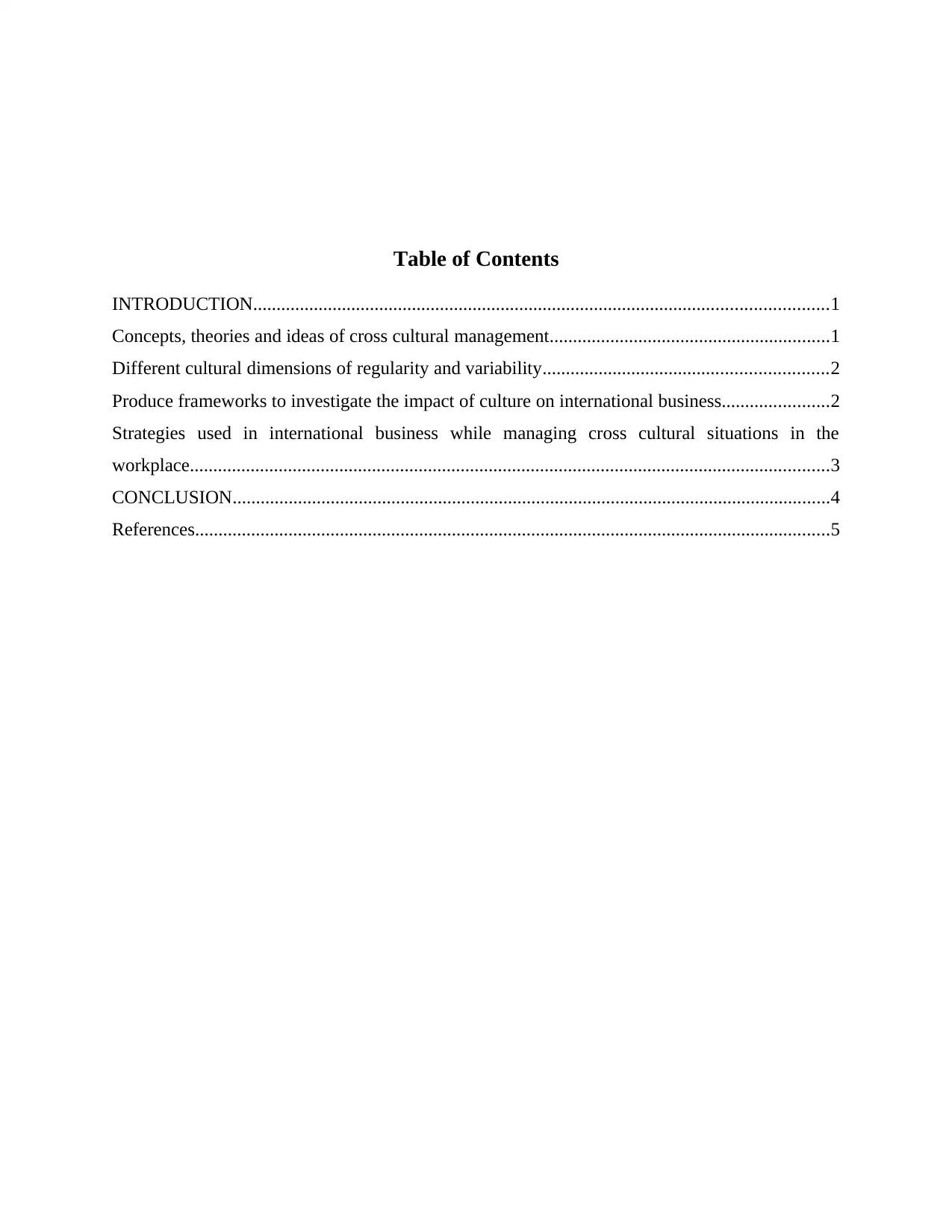
Table of Contents
INTRODUCTION...........................................................................................................................1
Concepts, theories and ideas of cross cultural management............................................................1
Different cultural dimensions of regularity and variability.............................................................2
Produce frameworks to investigate the impact of culture on international business.......................2
Strategies used in international business while managing cross cultural situations in the
workplace.........................................................................................................................................3
CONCLUSION................................................................................................................................4
References........................................................................................................................................5
INTRODUCTION...........................................................................................................................1
Concepts, theories and ideas of cross cultural management............................................................1
Different cultural dimensions of regularity and variability.............................................................2
Produce frameworks to investigate the impact of culture on international business.......................2
Strategies used in international business while managing cross cultural situations in the
workplace.........................................................................................................................................3
CONCLUSION................................................................................................................................4
References........................................................................................................................................5
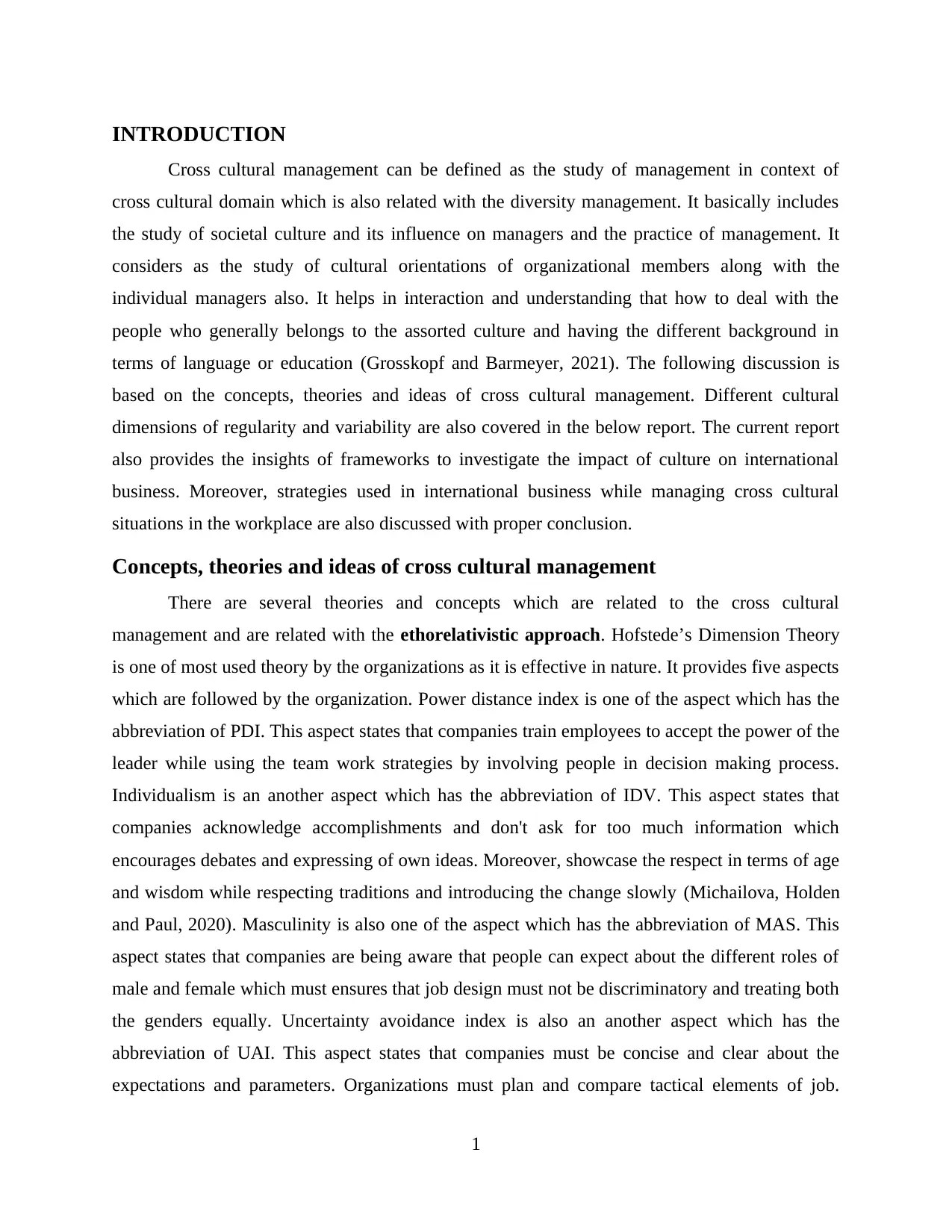
INTRODUCTION
Cross cultural management can be defined as the study of management in context of
cross cultural domain which is also related with the diversity management. It basically includes
the study of societal culture and its influence on managers and the practice of management. It
considers as the study of cultural orientations of organizational members along with the
individual managers also. It helps in interaction and understanding that how to deal with the
people who generally belongs to the assorted culture and having the different background in
terms of language or education (Grosskopf and Barmeyer, 2021). The following discussion is
based on the concepts, theories and ideas of cross cultural management. Different cultural
dimensions of regularity and variability are also covered in the below report. The current report
also provides the insights of frameworks to investigate the impact of culture on international
business. Moreover, strategies used in international business while managing cross cultural
situations in the workplace are also discussed with proper conclusion.
Concepts, theories and ideas of cross cultural management
There are several theories and concepts which are related to the cross cultural
management and are related with the ethorelativistic approach. Hofstede’s Dimension Theory
is one of most used theory by the organizations as it is effective in nature. It provides five aspects
which are followed by the organization. Power distance index is one of the aspect which has the
abbreviation of PDI. This aspect states that companies train employees to accept the power of the
leader while using the team work strategies by involving people in decision making process.
Individualism is an another aspect which has the abbreviation of IDV. This aspect states that
companies acknowledge accomplishments and don't ask for too much information which
encourages debates and expressing of own ideas. Moreover, showcase the respect in terms of age
and wisdom while respecting traditions and introducing the change slowly (Michailova, Holden
and Paul, 2020). Masculinity is also one of the aspect which has the abbreviation of MAS. This
aspect states that companies are being aware that people can expect about the different roles of
male and female which must ensures that job design must not be discriminatory and treating both
the genders equally. Uncertainty avoidance index is also an another aspect which has the
abbreviation of UAI. This aspect states that companies must be concise and clear about the
expectations and parameters. Organizations must plan and compare tactical elements of job.
1
Cross cultural management can be defined as the study of management in context of
cross cultural domain which is also related with the diversity management. It basically includes
the study of societal culture and its influence on managers and the practice of management. It
considers as the study of cultural orientations of organizational members along with the
individual managers also. It helps in interaction and understanding that how to deal with the
people who generally belongs to the assorted culture and having the different background in
terms of language or education (Grosskopf and Barmeyer, 2021). The following discussion is
based on the concepts, theories and ideas of cross cultural management. Different cultural
dimensions of regularity and variability are also covered in the below report. The current report
also provides the insights of frameworks to investigate the impact of culture on international
business. Moreover, strategies used in international business while managing cross cultural
situations in the workplace are also discussed with proper conclusion.
Concepts, theories and ideas of cross cultural management
There are several theories and concepts which are related to the cross cultural
management and are related with the ethorelativistic approach. Hofstede’s Dimension Theory
is one of most used theory by the organizations as it is effective in nature. It provides five aspects
which are followed by the organization. Power distance index is one of the aspect which has the
abbreviation of PDI. This aspect states that companies train employees to accept the power of the
leader while using the team work strategies by involving people in decision making process.
Individualism is an another aspect which has the abbreviation of IDV. This aspect states that
companies acknowledge accomplishments and don't ask for too much information which
encourages debates and expressing of own ideas. Moreover, showcase the respect in terms of age
and wisdom while respecting traditions and introducing the change slowly (Michailova, Holden
and Paul, 2020). Masculinity is also one of the aspect which has the abbreviation of MAS. This
aspect states that companies are being aware that people can expect about the different roles of
male and female which must ensures that job design must not be discriminatory and treating both
the genders equally. Uncertainty avoidance index is also an another aspect which has the
abbreviation of UAI. This aspect states that companies must be concise and clear about the
expectations and parameters. Organizations must plan and compare tactical elements of job.
1
⊘ This is a preview!⊘
Do you want full access?
Subscribe today to unlock all pages.

Trusted by 1+ million students worldwide
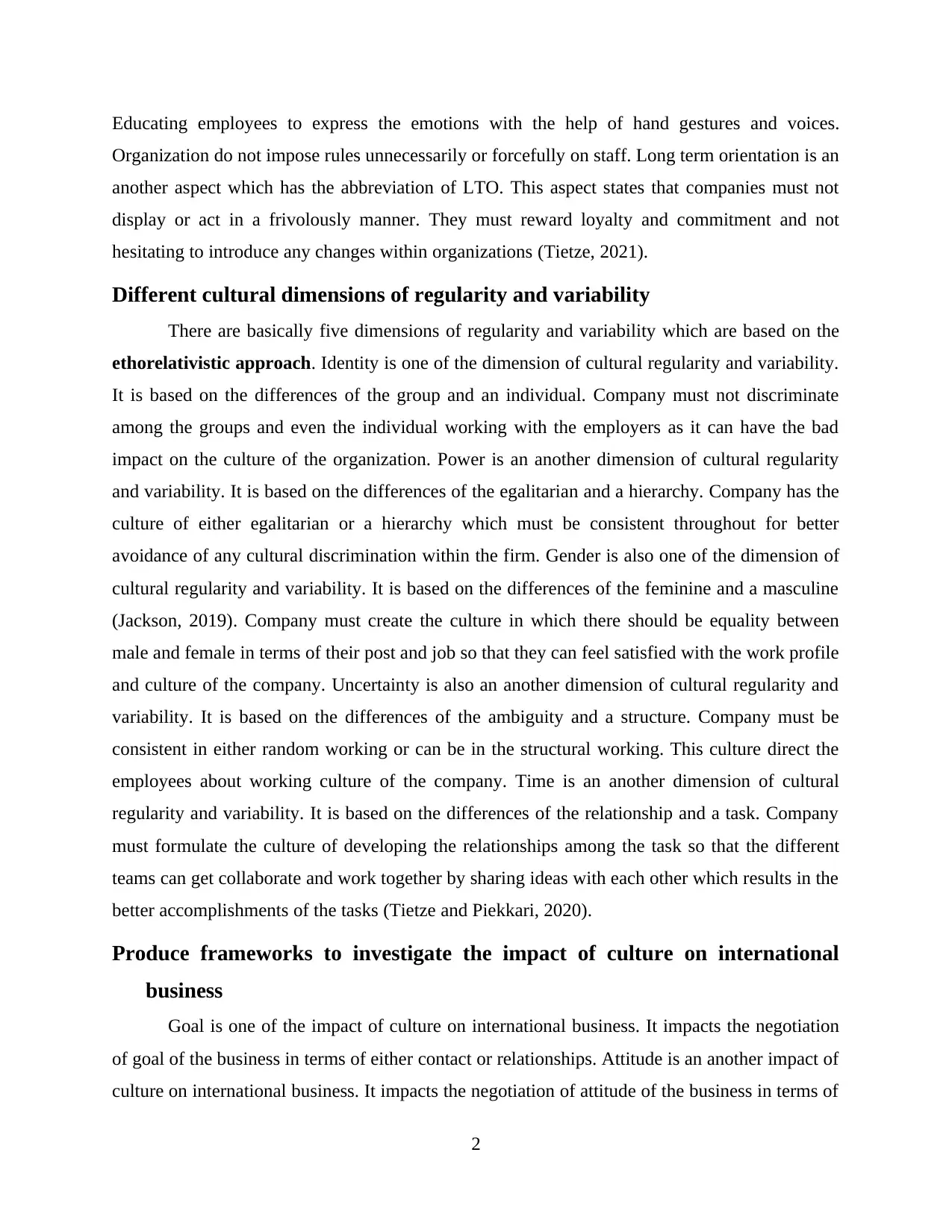
Educating employees to express the emotions with the help of hand gestures and voices.
Organization do not impose rules unnecessarily or forcefully on staff. Long term orientation is an
another aspect which has the abbreviation of LTO. This aspect states that companies must not
display or act in a frivolously manner. They must reward loyalty and commitment and not
hesitating to introduce any changes within organizations (Tietze, 2021).
Different cultural dimensions of regularity and variability
There are basically five dimensions of regularity and variability which are based on the
ethorelativistic approach. Identity is one of the dimension of cultural regularity and variability.
It is based on the differences of the group and an individual. Company must not discriminate
among the groups and even the individual working with the employers as it can have the bad
impact on the culture of the organization. Power is an another dimension of cultural regularity
and variability. It is based on the differences of the egalitarian and a hierarchy. Company has the
culture of either egalitarian or a hierarchy which must be consistent throughout for better
avoidance of any cultural discrimination within the firm. Gender is also one of the dimension of
cultural regularity and variability. It is based on the differences of the feminine and a masculine
(Jackson, 2019). Company must create the culture in which there should be equality between
male and female in terms of their post and job so that they can feel satisfied with the work profile
and culture of the company. Uncertainty is also an another dimension of cultural regularity and
variability. It is based on the differences of the ambiguity and a structure. Company must be
consistent in either random working or can be in the structural working. This culture direct the
employees about working culture of the company. Time is an another dimension of cultural
regularity and variability. It is based on the differences of the relationship and a task. Company
must formulate the culture of developing the relationships among the task so that the different
teams can get collaborate and work together by sharing ideas with each other which results in the
better accomplishments of the tasks (Tietze and Piekkari, 2020).
Produce frameworks to investigate the impact of culture on international
business
Goal is one of the impact of culture on international business. It impacts the negotiation
of goal of the business in terms of either contact or relationships. Attitude is an another impact of
culture on international business. It impacts the negotiation of attitude of the business in terms of
2
Organization do not impose rules unnecessarily or forcefully on staff. Long term orientation is an
another aspect which has the abbreviation of LTO. This aspect states that companies must not
display or act in a frivolously manner. They must reward loyalty and commitment and not
hesitating to introduce any changes within organizations (Tietze, 2021).
Different cultural dimensions of regularity and variability
There are basically five dimensions of regularity and variability which are based on the
ethorelativistic approach. Identity is one of the dimension of cultural regularity and variability.
It is based on the differences of the group and an individual. Company must not discriminate
among the groups and even the individual working with the employers as it can have the bad
impact on the culture of the organization. Power is an another dimension of cultural regularity
and variability. It is based on the differences of the egalitarian and a hierarchy. Company has the
culture of either egalitarian or a hierarchy which must be consistent throughout for better
avoidance of any cultural discrimination within the firm. Gender is also one of the dimension of
cultural regularity and variability. It is based on the differences of the feminine and a masculine
(Jackson, 2019). Company must create the culture in which there should be equality between
male and female in terms of their post and job so that they can feel satisfied with the work profile
and culture of the company. Uncertainty is also an another dimension of cultural regularity and
variability. It is based on the differences of the ambiguity and a structure. Company must be
consistent in either random working or can be in the structural working. This culture direct the
employees about working culture of the company. Time is an another dimension of cultural
regularity and variability. It is based on the differences of the relationship and a task. Company
must formulate the culture of developing the relationships among the task so that the different
teams can get collaborate and work together by sharing ideas with each other which results in the
better accomplishments of the tasks (Tietze and Piekkari, 2020).
Produce frameworks to investigate the impact of culture on international
business
Goal is one of the impact of culture on international business. It impacts the negotiation
of goal of the business in terms of either contact or relationships. Attitude is an another impact of
culture on international business. It impacts the negotiation of attitude of the business in terms of
2
Paraphrase This Document
Need a fresh take? Get an instant paraphrase of this document with our AI Paraphraser
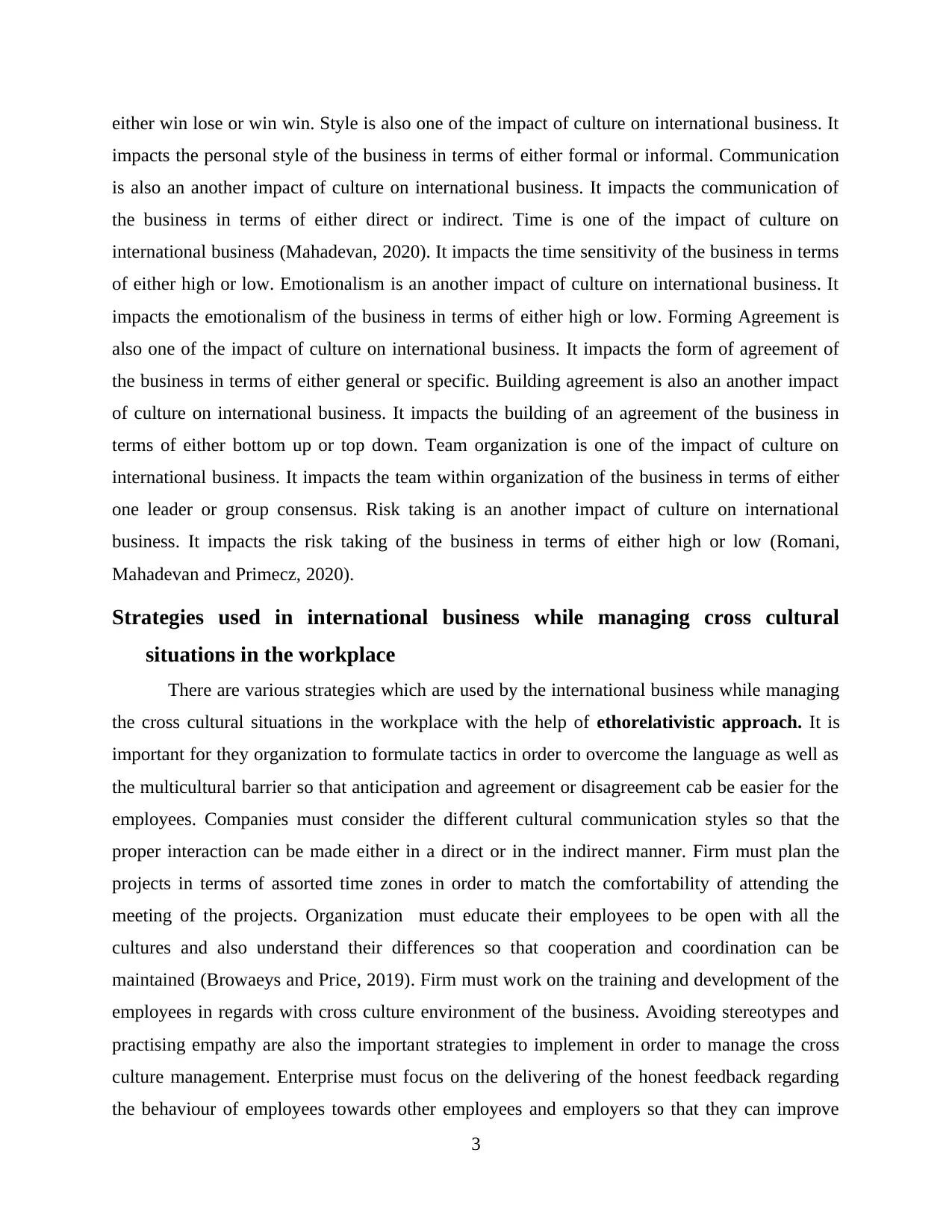
either win lose or win win. Style is also one of the impact of culture on international business. It
impacts the personal style of the business in terms of either formal or informal. Communication
is also an another impact of culture on international business. It impacts the communication of
the business in terms of either direct or indirect. Time is one of the impact of culture on
international business (Mahadevan, 2020). It impacts the time sensitivity of the business in terms
of either high or low. Emotionalism is an another impact of culture on international business. It
impacts the emotionalism of the business in terms of either high or low. Forming Agreement is
also one of the impact of culture on international business. It impacts the form of agreement of
the business in terms of either general or specific. Building agreement is also an another impact
of culture on international business. It impacts the building of an agreement of the business in
terms of either bottom up or top down. Team organization is one of the impact of culture on
international business. It impacts the team within organization of the business in terms of either
one leader or group consensus. Risk taking is an another impact of culture on international
business. It impacts the risk taking of the business in terms of either high or low (Romani,
Mahadevan and Primecz, 2020).
Strategies used in international business while managing cross cultural
situations in the workplace
There are various strategies which are used by the international business while managing
the cross cultural situations in the workplace with the help of ethorelativistic approach. It is
important for they organization to formulate tactics in order to overcome the language as well as
the multicultural barrier so that anticipation and agreement or disagreement cab be easier for the
employees. Companies must consider the different cultural communication styles so that the
proper interaction can be made either in a direct or in the indirect manner. Firm must plan the
projects in terms of assorted time zones in order to match the comfortability of attending the
meeting of the projects. Organization must educate their employees to be open with all the
cultures and also understand their differences so that cooperation and coordination can be
maintained (Browaeys and Price, 2019). Firm must work on the training and development of the
employees in regards with cross culture environment of the business. Avoiding stereotypes and
practising empathy are also the important strategies to implement in order to manage the cross
culture management. Enterprise must focus on the delivering of the honest feedback regarding
the behaviour of employees towards other employees and employers so that they can improve
3
impacts the personal style of the business in terms of either formal or informal. Communication
is also an another impact of culture on international business. It impacts the communication of
the business in terms of either direct or indirect. Time is one of the impact of culture on
international business (Mahadevan, 2020). It impacts the time sensitivity of the business in terms
of either high or low. Emotionalism is an another impact of culture on international business. It
impacts the emotionalism of the business in terms of either high or low. Forming Agreement is
also one of the impact of culture on international business. It impacts the form of agreement of
the business in terms of either general or specific. Building agreement is also an another impact
of culture on international business. It impacts the building of an agreement of the business in
terms of either bottom up or top down. Team organization is one of the impact of culture on
international business. It impacts the team within organization of the business in terms of either
one leader or group consensus. Risk taking is an another impact of culture on international
business. It impacts the risk taking of the business in terms of either high or low (Romani,
Mahadevan and Primecz, 2020).
Strategies used in international business while managing cross cultural
situations in the workplace
There are various strategies which are used by the international business while managing
the cross cultural situations in the workplace with the help of ethorelativistic approach. It is
important for they organization to formulate tactics in order to overcome the language as well as
the multicultural barrier so that anticipation and agreement or disagreement cab be easier for the
employees. Companies must consider the different cultural communication styles so that the
proper interaction can be made either in a direct or in the indirect manner. Firm must plan the
projects in terms of assorted time zones in order to match the comfortability of attending the
meeting of the projects. Organization must educate their employees to be open with all the
cultures and also understand their differences so that cooperation and coordination can be
maintained (Browaeys and Price, 2019). Firm must work on the training and development of the
employees in regards with cross culture environment of the business. Avoiding stereotypes and
practising empathy are also the important strategies to implement in order to manage the cross
culture management. Enterprise must focus on the delivering of the honest feedback regarding
the behaviour of employees towards other employees and employers so that they can improve
3
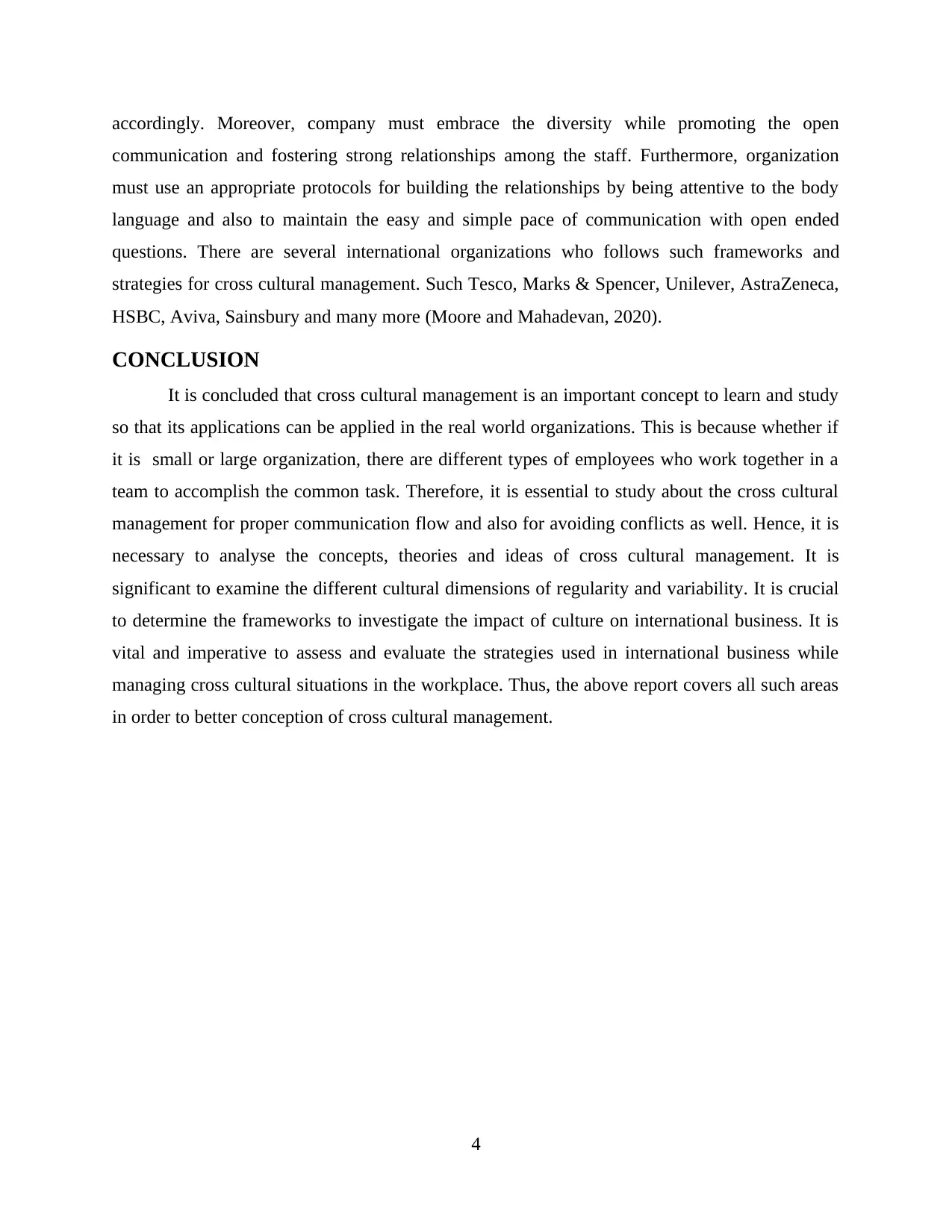
accordingly. Moreover, company must embrace the diversity while promoting the open
communication and fostering strong relationships among the staff. Furthermore, organization
must use an appropriate protocols for building the relationships by being attentive to the body
language and also to maintain the easy and simple pace of communication with open ended
questions. There are several international organizations who follows such frameworks and
strategies for cross cultural management. Such Tesco, Marks & Spencer, Unilever, AstraZeneca,
HSBC, Aviva, Sainsbury and many more (Moore and Mahadevan, 2020).
CONCLUSION
It is concluded that cross cultural management is an important concept to learn and study
so that its applications can be applied in the real world organizations. This is because whether if
it is small or large organization, there are different types of employees who work together in a
team to accomplish the common task. Therefore, it is essential to study about the cross cultural
management for proper communication flow and also for avoiding conflicts as well. Hence, it is
necessary to analyse the concepts, theories and ideas of cross cultural management. It is
significant to examine the different cultural dimensions of regularity and variability. It is crucial
to determine the frameworks to investigate the impact of culture on international business. It is
vital and imperative to assess and evaluate the strategies used in international business while
managing cross cultural situations in the workplace. Thus, the above report covers all such areas
in order to better conception of cross cultural management.
4
communication and fostering strong relationships among the staff. Furthermore, organization
must use an appropriate protocols for building the relationships by being attentive to the body
language and also to maintain the easy and simple pace of communication with open ended
questions. There are several international organizations who follows such frameworks and
strategies for cross cultural management. Such Tesco, Marks & Spencer, Unilever, AstraZeneca,
HSBC, Aviva, Sainsbury and many more (Moore and Mahadevan, 2020).
CONCLUSION
It is concluded that cross cultural management is an important concept to learn and study
so that its applications can be applied in the real world organizations. This is because whether if
it is small or large organization, there are different types of employees who work together in a
team to accomplish the common task. Therefore, it is essential to study about the cross cultural
management for proper communication flow and also for avoiding conflicts as well. Hence, it is
necessary to analyse the concepts, theories and ideas of cross cultural management. It is
significant to examine the different cultural dimensions of regularity and variability. It is crucial
to determine the frameworks to investigate the impact of culture on international business. It is
vital and imperative to assess and evaluate the strategies used in international business while
managing cross cultural situations in the workplace. Thus, the above report covers all such areas
in order to better conception of cross cultural management.
4
⊘ This is a preview!⊘
Do you want full access?
Subscribe today to unlock all pages.

Trusted by 1+ million students worldwide
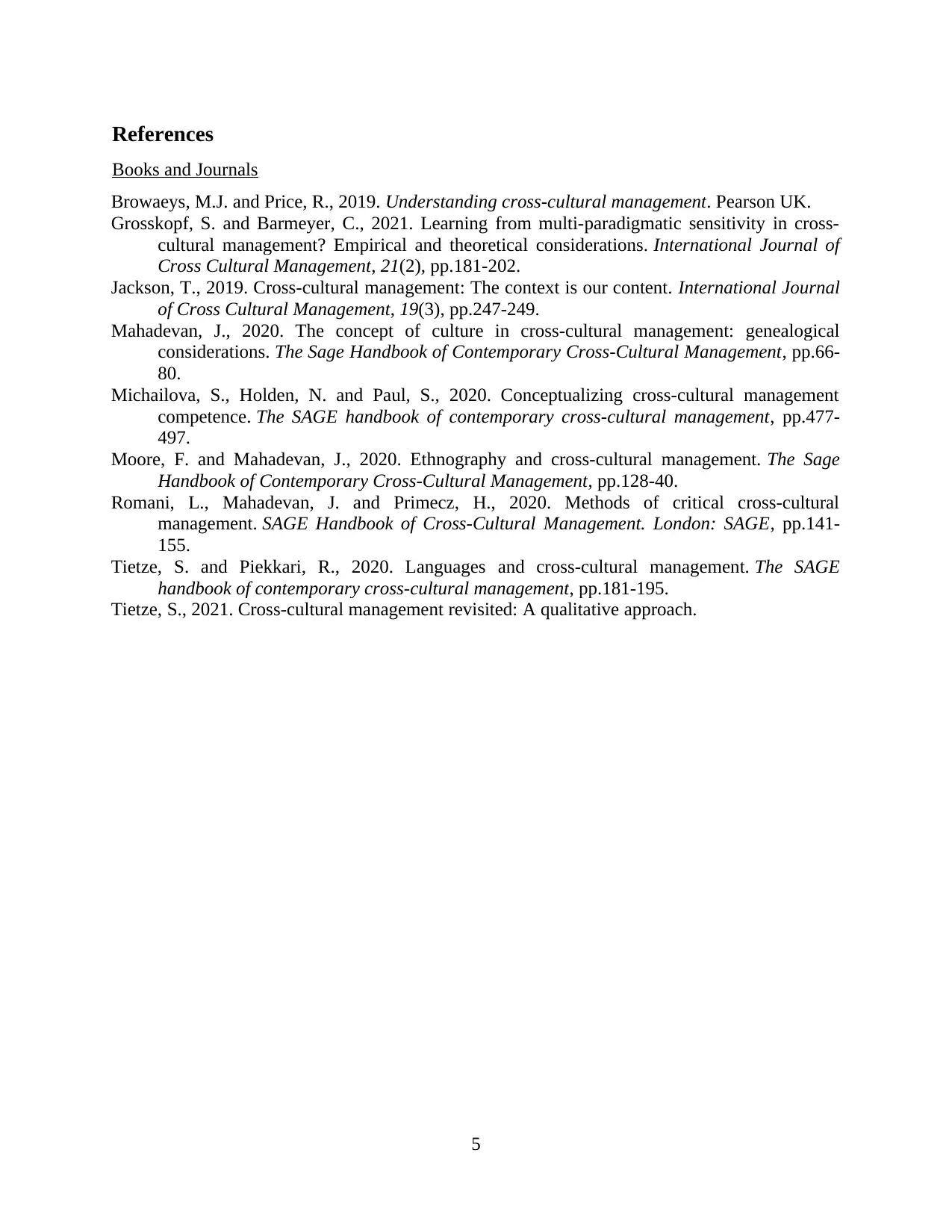
References
Books and Journals
Browaeys, M.J. and Price, R., 2019. Understanding cross-cultural management. Pearson UK.
Grosskopf, S. and Barmeyer, C., 2021. Learning from multi-paradigmatic sensitivity in cross-
cultural management? Empirical and theoretical considerations. International Journal of
Cross Cultural Management, 21(2), pp.181-202.
Jackson, T., 2019. Cross-cultural management: The context is our content. International Journal
of Cross Cultural Management, 19(3), pp.247-249.
Mahadevan, J., 2020. The concept of culture in cross-cultural management: genealogical
considerations. The Sage Handbook of Contemporary Cross-Cultural Management, pp.66-
80.
Michailova, S., Holden, N. and Paul, S., 2020. Conceptualizing cross-cultural management
competence. The SAGE handbook of contemporary cross-cultural management, pp.477-
497.
Moore, F. and Mahadevan, J., 2020. Ethnography and cross-cultural management. The Sage
Handbook of Contemporary Cross-Cultural Management, pp.128-40.
Romani, L., Mahadevan, J. and Primecz, H., 2020. Methods of critical cross-cultural
management. SAGE Handbook of Cross-Cultural Management. London: SAGE, pp.141-
155.
Tietze, S. and Piekkari, R., 2020. Languages and cross-cultural management. The SAGE
handbook of contemporary cross-cultural management, pp.181-195.
Tietze, S., 2021. Cross-cultural management revisited: A qualitative approach.
5
Books and Journals
Browaeys, M.J. and Price, R., 2019. Understanding cross-cultural management. Pearson UK.
Grosskopf, S. and Barmeyer, C., 2021. Learning from multi-paradigmatic sensitivity in cross-
cultural management? Empirical and theoretical considerations. International Journal of
Cross Cultural Management, 21(2), pp.181-202.
Jackson, T., 2019. Cross-cultural management: The context is our content. International Journal
of Cross Cultural Management, 19(3), pp.247-249.
Mahadevan, J., 2020. The concept of culture in cross-cultural management: genealogical
considerations. The Sage Handbook of Contemporary Cross-Cultural Management, pp.66-
80.
Michailova, S., Holden, N. and Paul, S., 2020. Conceptualizing cross-cultural management
competence. The SAGE handbook of contemporary cross-cultural management, pp.477-
497.
Moore, F. and Mahadevan, J., 2020. Ethnography and cross-cultural management. The Sage
Handbook of Contemporary Cross-Cultural Management, pp.128-40.
Romani, L., Mahadevan, J. and Primecz, H., 2020. Methods of critical cross-cultural
management. SAGE Handbook of Cross-Cultural Management. London: SAGE, pp.141-
155.
Tietze, S. and Piekkari, R., 2020. Languages and cross-cultural management. The SAGE
handbook of contemporary cross-cultural management, pp.181-195.
Tietze, S., 2021. Cross-cultural management revisited: A qualitative approach.
5
1 out of 7
Related Documents
Your All-in-One AI-Powered Toolkit for Academic Success.
+13062052269
info@desklib.com
Available 24*7 on WhatsApp / Email
![[object Object]](/_next/static/media/star-bottom.7253800d.svg)
Unlock your academic potential
Copyright © 2020–2025 A2Z Services. All Rights Reserved. Developed and managed by ZUCOL.



